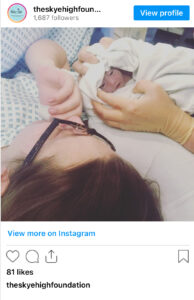Millie Smith and Lewis Cann found out they were expecting twin girls just a few weeks before, and only one of them would make it out alive.
After 30 weeks of a high-risk pregnancy, Smith gave birth to identical twins, Callie and Skye, on April 30. Skye, who lived for only three hours, did not survive.
Later, Callie slept in the incubator in the newborn intensive care unit (NICU) without her sister, her parents watching over her in love and grief. An overburdened mother of healthy newborn twins told Smith, rather naively, that she was “so lucky” not to have two babies on the unit with the other babies.
The new mother was crushed by the comments and found it unable to put her sorrow into words. She later understood that Skye’s legacy—which took the shape of a purple butterfly—was to support other families who have lost a child.
Millie Smith and her partner Lewis Cann learned they were expecting their first child in November 2015. Smith, whose family includes twins, claimed she had a “gut feeling” that she would have two children. Ten weeks later, medical professionals confirmed that Smith was carrying identical twin girls.
The British couple were saddened to find that one of their infants had a fatal disease and would not live after birth, less than two weeks after they had been thrilled to learn they would have twice as many children in their home.
“The doctor said nothing while the scan was happening. She said nothing, but I was giddy with excitement and adored seeing the small infants. Lewis and I both saw there had to be an issue right away,” Smith remarked.
Physicians announced that one of the infants had anencephaly, a condition that affects roughly one in 4,600 babies in the United States, according to the Centers for Disease Control and Prevention (CDC). When a baby is born without portions of its brain or skull, it is a significant birth condition, and “nearly all babies born with anencephaly will die shortly after birth.”

With the knowledge that their firstborn would not survive long after birth and that their secondborn would be at risk, the couple chose to proceed with the exceedingly dangerous pregnancy.
Smith and Cann gave their twins Skye and Callie names throughout the course of the following few months. Smith stated, “We were aware that Skye needed a name before she was born.” “I wanted her to be named in the few seconds or minutes that she would live, knowing that.”
“Skye meant somewhere we knew she would always be, that we could look up at the sky and remember our baby,” the speaker clarified.
Smith required an emergency C-section on April 30 after only 30 weeks of pregnancy when she went into labor. The couple was given a “bereavement midwife” after the birth to help them deal with the loss, and they were placed in a special room known as the “Daisy Room,” where families can spend time with a newborn both before and after she or he passes away.
“When the girls were born, they both cried. This was a huge moment, as we were told that Skye would not make a noise or move,” said Smith, who was thankful to have three hours with Skye before she died. “We were cuddling Skye when she passed away. This was the worst moment in our lives. I have never ever felt heartbreak like that before. But I am proud that she fought for so long to spend time with us.”
Born premature, Callie had to stay in NICU while she gained some strength and also in the unit were three other sets of twin.
“Most of the nurses were aware of what had happened, but as time passed, people stopped talking about Skye. After about four weeks, everyone acted as though nothing had happened, meaning the families around me had no idea about our situation,” Smith recalled.
One morning, a stressed mother whose twins were also in NICU, harmlessly said to Smith that she was “so lucky” to not have twins.
“None of the other parents knew what had happened or anything about Skye. The comment was completely innocent and more out of humor…They weren’t to know that I did at one point have two.” Smith continued, “But the comment nearly broke me. I ran out [of] the room in tears and they had no idea why. I didn’t have the heart to tell them what had happened. A simple sticker would have avoided that entire situation.”
It was in that moment Smith realized she had to create something that would speak for parents who had just lost a baby, ensuring the misunderstanding never happens again.
She designed a poster for the NICU explaining both hospital personnel and visitors that any incubator with a purple butterfly on it means that one or more babies, in a set of multiples were lost.
“I chose butterflies, as I felt it was fitting to remember the babies that flew away, the color purple because it is suitable for both boys or girls,” said Smith.
The purple butterfly concept–now under the Skye High Foundation–has spread to hospitals in several countries around the world.
Happy 6th Birthday to Callie and Skye. 6 whole years since we welcomed you to the world 💜
Callie is now a lively, happy seven-year-old, and twin’s memory lives in purple butterfly cards along with other initiatives to help families with babies like Skye all over the world. The purple butterflies now come in numerous forms, like ornaments, cards, blankets, stuffed animals and more.
“Ultimately I will never be able to stop this from happening but the more support groups we can set up and put things in place like the stickers the better it will be. It’s the hardest thing anyone has to deal with,” Smith said.
Losing a child of any age can’t be easy for a parent and the world is blessed for people like Millie Smith who’s aiming to help others.


